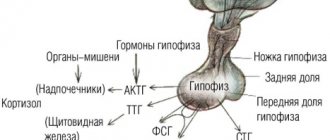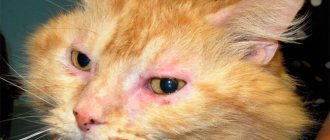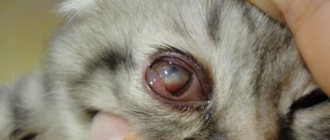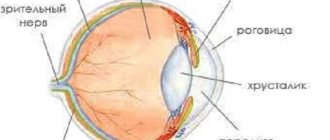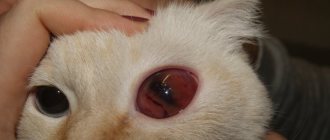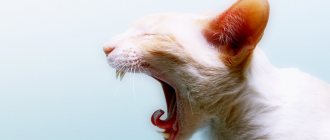Every person knows that the nose is a unique indicator of an animal’s health. But many people forget that the eyes can also signal poor health and the development of pathology in the animal.
What eye diseases occur in cats, as well as methods of treating them, will be discussed in this article.
Causes of eye disease
Before we talk about the types and symptoms of eye diseases, you need to know what a cat’s eyes should look like without pathologies.
Healthy eyes should not have clouding or redness in the whites, and the eyelids should be properly shaped without redness, suppuration or swelling. Light discharge from the corners of the eyes is acceptable, which is almost invisible.
Important: discharge from the eyes is not always a symptom. For example, some breeds suffer from narrowing of the tear ducts and curvature of the nasal passages; frequent eye discharge is not a symptom of eye disease in cats of the British, Persian and Scottish breeds.
Among all the causes of eye diseases, the most common are:
- Poor nutrition, lack of vitamins and metabolic disorders;
- Eye injuries, bruises, blows and concussions;
- Unsatisfactory living conditions;
- The cat's susceptibility to stress;
- Problems with fluid inside the eyeball;
- Slow metabolism associated with the age of the cat.
Causes of discharge
There are many reasons for such a deviation.
Anatomically determined lacrimation
In some cases, the cause of tearing is an anatomical predisposition. Discharge and inflammatory processes can occur due to congenital pathology of the animal. This most often affects Sphynx, Persian, British, Scottish and other exotic short-faced cats.
For your information! In a normal state, tears flow into a special nasolacrimal canal, but since the pet’s canal has some disturbances, tears flow into the periocular area.
If the cause of the obstruction is an overgrown or blocked canal, then the problem can be solved by surgical intervention. Unfortunately, surgery is not omnipotent, so there is no guarantee of a positive outcome. In addition, relapses may occur after surgery, so this type of treatment is used very rarely.
If the nasolacrimal duct is obstructed, cats may develop chronic conjunctivitis. To prevent it, it will be enough to carry out daily hygiene care using special lotions. In case of complications, the pet will require periodic antimicrobial and anti-inflammatory therapy.
Allergic reactions
Allergic reactions can occur as a result of animal contact with allergens. Signs of an allergy are frequent sneezing, wet eyes (fluid without pus or other signs of inflammation). This reaction can be triggered by cat food, contact with detergent (typical cat allergens are detergent particles dissolved in the air), medications, a vaccine or a houseplant (allergic reactions to pollen are quite rare). The simplest treatment is to eliminate the cause of the allergy.
Bacterial conjunctivitis
Conjunctivitis is a fairly common eye disease in cats. With conjunctivitis, the conjunctiva becomes inflamed. The conjunctiva is the thin mucous membrane that covers the eyeballs and the inside of the eyelids. It contains the flow channels of the lacrimal glands, which protect the cat's eye from drying out and from small foreign bodies.
Conjunctivitis in cats
Symptoms of conjunctivitis:
- lacrimation and redness of the eyes. The eyelids may swell or experience pain and discomfort when exposed to light. Eyes may change color and become cloudy;
- the movements of the eyeballs are disrupted, and the eyelids become everted.
Note! Catarrhal conjunctivitis is most often observed in cats. This is the most harmless type, which can be treated with standard methods under the supervision of a veterinarian. Characteristic signs are red eyes, swelling of the eyelid mucosa, and an inflamed eye that does not open.
With purulent conjunctivitis in cats, colored fluid begins to ooze from the eyes, and the eye may fester. At the initial stage, yellowish crusts and liquid green-yellow pus can be seen in the eye area. Lack of treatment will lead to serious complications - keratitis, panophthalmitis and blindness.
In the case of follicular conjunctivitis in cats, in addition to the mucous membrane of the eyelids, the lymphatic follicles also become inflamed. The animal will need veterinary care, and treatment may take a long period. Follicles are often removed through surgery, after which a course of treatment is prescribed.
Injury
Eye damage is a very serious problem that can lead to complete loss of vision. Therefore, in case of injury, it is necessary to urgently seek qualified help. Symptoms of eye damage are profuse lacrimation (both with and without particles of pus), unevenness on the cornea, redness of the periocular area.
Eye injuries
Age-related lacrimation (tears in kittens)
A common cause of watery eyes is age-related symptoms. Young kittens (2-8 weeks) and older cats (8 years and older) may suffer from heavy discharge in the eye area. If the secreted liquid is transparent and the animal’s eyes are not inflamed, then hygienic treatment will be sufficient. Watery eyes can also cause decreased immunity. Therefore, it is recommended to take the animal to a veterinarian for examination and determination of the cause.
Foreign object in the eye
If even a small foreign body gets into an animal's eye, serious inflammation can occur, the organ will turn red and increase in size. The fact is that microorganisms located on the surface of an object can cause the development of diseases such as keratitis, uveitis, purulent conjunctivitis, retinal hemorrhage, and also lead to loss of vision.
Important! Sometimes it happens that a particle gets into the eye and initially does not cause discomfort in the cat. But if a foreign object remains in the inner part of the eye for a long time, it provokes various inflammations, including blindness and even the need to remove the eyeball. Therefore, if a cat’s eye is watery and there is a suspicion that a foreign object has gotten into it, you should consult a veterinarian.
Parasites
The cause of the discharge may be parasites in the cat's body. Their presence is checked by analyzing the animal's feces for helminths. If a cat is found to have worms, it is necessary to deworm it.
Types of eye diseases in cats
The entire mass of eye pathologies can be divided into two groups:
- Infectious diseases accompanied by inflammation;
- Non-infectious, which occur without inflammatory processes.
Infectious diseases are a consequence of the activity of pathogenic microorganisms that infect an animal.
The causative agents of the disease can be viruses, fungi or bacteria that a cat can become infected with from another animal.
Non-infectious diseases include all pathologies not associated with the result of the activity of microorganisms.
This can be as a consequence of injuries and changes in the physiological processes of the animal, such as a decrease in metabolism, stress, or a foreign body entering the eye.
Possible reasons
Normally, tear fluid is constantly secreted, as it prevents the eyeballs from drying out, and with its help, foreign particles and microbes are removed from the eyes. But a normal amount of tears is invisible to others. And only when this fluid is produced in excessive quantities does the cat begin to “cry.”
All the reasons why increased lacrimation may develop can be divided into two categories: physiological and pathological.
Physiological causes of lacrimation
. Tear fluid is produced by special glands that “receive signals” from receptors located in the mucous membrane of the eyelids and conjunctiva. When dust, fur, smoke or other harmful and foreign particles enter a cat's eyes, the receptors are irritated and stimulate the production of more tear fluid. This is a normal process that allows tears to wash away foreign particles and cleanse the eyes.
Pathological causes of lacrimation
. In this case, lacrimation most often develops in response to inflammation of the conjunctiva. It can be caused by injury, exposure to aggressive chemical compounds in the eyes, allergies, viral or bacterial diseases, disruption of the outflow of tears, anatomical defects and other reasons. In this case, the mechanism of lacrimation does not differ from the physiological one, with the only difference being that the increased secretion of tear fluid occurs under the influence of inflammatory mediators.
Diseases in which lacrimation develops can occur in different forms:
- in acute (sharp onset of the disease and pronounced symptoms);
- chronic (alternating periods of remission, when there are practically no symptoms or they manifest themselves weakly, and periods of exacerbation, when the disease develops in the same way as in the acute course).
In addition, conjunctivitis may not be an independent ophthalmological disease, but a symptom of renal dysfunction, a general allergic reaction, viral rhinotracheitis and other pathologies.
The most common diseases and treatments
Although there are a large number of pathologies that affect the eyes of cats, some of them are much more common than others.
Below is a list of the most common diseases and symptoms of eye diseases in cats, as well as methods of treating them.
Glaucoma
A disease leading to complete loss of vision due to damage to the optic nerve as a result of increased intraocular pressure and decreased outflow of ocular fluid.
Developing glaucoma can be identified by several symptoms:
- dilated pupils, slow reaction to light or its complete loss;
- redness of the protein due to vasodilation;
- darkening of the front of the eye.
Often, a cat with developing glaucoma may experience a fear of light and squint its eye.
Seizures in cats - main causes, symptoms, first aid, treatment and choice of drugs (110 photos)Polycystic kidney disease in cats - causes, diagnosis and symptoms of the disease. Treatment options and prevention of kidney disease (95 photos)
Tartar in cats - signs of the disease and methods of fully treating tartar (125 photos + video)
Treatment is possible only after examining the animal by a veterinarian and is aimed at reducing intraocular pressure with the help of medications to reduce pain and preserve vision.
If there is no response to medications, surgery is necessary to remove part of the ciliary body of the eye.
If the eye has completely lost vision, it is removed to relieve pain.
Keratitis
Damage to the cornea, which is accompanied by inflammation and clouding of the eye. The most noticeable symptoms of keratitis:
- accumulation of fluid under the cornea;
- copious mucous and purulent discharge;
- clouding of the cornea of the eye. In some cases, germination of the cornea by blood vessels is possible.
- corneal damage. This can be mechanical damage as a result of injury, foreign body, or chemical damage or burn;
- infections and infectious diseases that become the basis for the development of other diseases;
- viruses;
- decreased cat immunity, vitamin deficiency and metabolic disorders.
Treatment of keratitis occurs only under the supervision of a veterinarian after identifying the cause of keratitis.
Ringworm in cats - main signs, symptoms, prevention and treatment of ringworm in cats (105 photos)Pancreatitis in cats: first symptoms, nutritional nuances and treatment options (125 photos and videos)
Subcutaneous mites in cats - first symptoms, treatment options and real photos of examples of parasite damage (110 photos + video)
If the causative agent of keratitis is an infection or a virus, antibacterial and antiviral drugs based on interoferon are used.
“Direct” causes of watery eyes
- Foreign body. A small grain of sand or hair that gets into the eye causes a response from the body - profuse lacrimation. This is necessary in order to wash away the foreign object without damaging the cornea and mucous membrane of the eyelids. If you are confident in your abilities, then you can use eye drops (not medicinal with antibiotics, but natural tears) or a large amount of boiled water, which you have cooled first (do not pour boiling water or hot water on the cat’s eyes), and carefully rinse the eye. Try to make the liquid flow to the inner corner, this will make it easier to remove the foreign body. Don’t forget to secure the cat well in advance; you can even wrap it in a thick blanket/blanket or ask an adult family member to help hold the crying pet. If you yourself cannot or do not see the reason, go to the veterinarian to prevent solid microparticles from getting under the upper eyelid.
- Eye injury. This can be either a bruise (maybe the pet was running and did not have time to maneuver, sticking its muzzle into an obstacle), or a serious injury. For example, you witnessed a fight between your cat and another animal, or the purr accidentally scratched itself. Then a scratch appears on the cornea, which you cannot see yourself; a thorough examination is needed through a device in the veterinarian’s office.
- Inflammatory processes. Here is a huge list of problems: blepharitis, iridocyclitis, uveitis, conjunctivitis and keratoconjunctivitis. By the way, inflammation of the conjunctiva is not always an “independent” disease. This is often a symptom of an infection or parasite.
- Predisposition. It is no secret that many breeds are predisposed to diseases. So, the eyes of a cat (Persian and other “short-faced” cats, Sphynx) water much more often than those of other breeds. However, one should not rely only on genetics; it is better to consult.
- Turn of the century. In this case, the eyelashes irritate the cat's eye, causing him not only discomfort, but also pain. The problem should be solved exclusively by surgical methods.
- Narrowing of the tear duct. This disease is also registered in small children, so such an anomaly can be suspected even in the kitten’s childhood. An experienced veterinarian-ophthalmologist will solve this problem.
Blepharitis
A disease that causes inflammation of an animal's eyelids. Often confused with conjunctivitis due to similar symptoms. To understand how to treat this eye disease in cats, you first need to determine the type and cause of the disease.
There are three types of this pathology:
Meibomian - occurs due to the penetration of pathogenic microorganisms into the ducts of the meibomian glands. As a result, inflammation begins, the eyelids turn red, tearing increases and purulent discharge appears.
Scaly - inflammation with the appearance of scales on the eyelids, which leads to loss of eyelashes and purulent discharge if left untreated.
Ulcerative is a disease that develops from scaly without the necessary treatment. After the purulent masses dry out, ulcers appear on the surface of the eyelids, and when they heal, scar tissue forms, tightening the skin and causing entropion of the eyelids.
If the causative agent of blepharitis is an infection, then antibiotics in the form of injections or ointments are used for treatment. Fungal blepharitis is treated with fungicidal ointments.
In addition, it is necessary to treat the surface of the eyelids themselves. To do this, they are treated with an antiseptic, the scales at the roots of the eyelashes and dried pus are softened with Vaseline, after which they are removed and special drops are instilled into the eyes.
In addition to the medications prescribed by the veterinarian, it is necessary to rinse the eyes to remove purulent discharge and scales that form.
Rinsing is done with a warm decoction of chamomile or calendula. It is also necessary to add phytomins for the eyes and fortified supplements to the cat's food.
Prevention to prevent diseases
Treating an already developing pathology is much more difficult than taking measures to minimize the chance of an animal becoming ill. In order for your cat to be healthy and the risk of disease to be minimal, it is enough to follow a few simple rules:
- Conduct a preventive examination at the veterinary clinic and receive vaccinations recommended by the veterinarian on time;
- avoid contact with street animals; after a walk on the street, examine the cat for eye injuries and the presence of foreign objects;
- add vitamins and healthy supplements to your cat’s food;
- Regularly trim nails, comb and examine eyes for discharge.
When faced with an eye disease in a cat, the first thing you need to do is take the animal to a veterinarian.
Many owners, when their pet becomes ill, begin to look for information and methods of treatment based on photos of eye diseases in their cats, which should not be done under any circumstances, since improper treatment may lead to consequences in the form of complications or the development of more serious diseases.
Photos of eye diseases in cats
Read here Seizures in cats - main causes, symptoms, first aid, treatment and choice of drugs (110 photos)
Help the site, share with friends 
How to deal with lacrimation in a cat?
If your cat begins to show any symptoms of conjunctivitis, the only correct solution in this case is to contact a veterinarian. After examination and appropriate examination, the specialist will determine the cause of the disease, all its features and prescribe the treatment necessary in a particular case.
Before visiting a doctor, you should eliminate all irritating factors (bright light, dust, etc.) and create the most calm and comfortable conditions for your cat.
It is important to understand that self-medication is unacceptable - there are no universal remedies that could cope with conjunctivitis of viral, bacterial, allergic or other origin with equal effectiveness.

